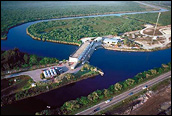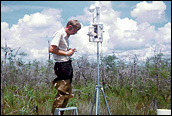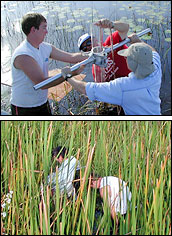

Florida Before Farming | |||
Before humans constructed drainage canals, dams, dikes, and reservoirs, much of central and southern Florida was covered with one kind of wetland or another. From swampy forests dominated by giant cypress trees, to bogs and various types of marshes, to the tree-island-dotted Everglades, almost every ecosystem on North America’s southeastern tip was under the sway of water. Runoff from the north kept the Kissimmee River Floodplain in the central part of the peninsula almost perpetually under water. From there the water flowed south into Lake Okeechobee. The spillover from the lake glided slowly over the Everglades in a slow-moving, horizontal sheet. Today's flow is dramatically reduced, and the Everglades are only about half the size they once were. |

Human-made structures now control the flow of water in the Everglades, disrupting natural cycles. (Photograph courtesy South Florida Water Management District) | ||

The change has had profound ecological consequences, but could the transformation of this world of free-flowing water into the agricultural and urban lands of today have actually changed the weather? After the soaking that Florida got from four hurricanes in 2004, it’s easy to forget that between 1997 and 2001, Florida suffered through five consecutive summers of drought, much of it extreme. In January 1997, a surprising freeze event caught Florida farmers off guard, causing the near-total loss of winter crops in the cultivated areas south of Lake Okeechobee. The increased public perception that droughts and freezes in Florida were becoming more frequent and severe focused Pielke’s thoughts on the question of whether, if that were true, land cover might have had something to do with it. |
The natural landscape of southern Florida was dominated by wetlands. Rainfall in central Florida feeds the Kissimmee River, which flows into Lake Okeechobee. The southern extent of Lake Okeechobee spills over into the seemingly endless Everglades, which join with coastal mangrove forests. (Map courtesy USGS National Water-Quality Assessment Program) | ||
Experiments with the WeatherIt was an idea that had grown in Pielke’s mind over the course of his career, with the seed planted as far back as 30 years ago, when he worked with cloud-modeling pioneer Joanne Simpson. Pielke’s task was to develop a model of Florida’s weather behavior that they could use to better understand the results of cloud “seeding” experiments, in which scientists tried to entice clouds to produce rain. Pielke’s three-dimensional model of Florida’s weather evolved over the years. Fifteen years ago, he consolidated his model with a model developed by fellow Colorado State University atmospheric scientist Bill Cotton and colleagues Craig Tremback and Bob Walko. They called the modeling system the Regional Atmospheric Modeling System, or RAMS. To figure out if the weather that existed with the present-day landscape was different from the weather that would have occurred if the natural landscape had remained required two main ingredients: a model of how the land and atmosphere interact to produce the weather, and a detailed map of land cover in Florida—not just for the present but for the past as well. The study would require expertise in climatology, remote sensing, ecology, hydrology, and geology. |

Roger Pielke began studying Florida’s weather to support weather-modification experiments in the early 1970s. In this photograph he adjusts a remote weather station in Florida marshland. (Photograph courtesy Roger Pielke) | ||
The need for interdisciplinary expertise is what brought Pielke and Curtis Marshall, a meteorologist from the NOAA National Centers for Environmental Prediction and Pielke’s student at the time, together with Lou Steyaert of the U.S. Geological Survey (USGS) and NASA, and paleobotanist Deb Willard of the USGS, who has collected and analyzed pollen in soil samples cored out of Florida’s wet and dry lands for the past 10 years. It was Steyaert who wrote the proposal for funding for the project and arranged for Pielke to be the lead scientist. Pielke planted the idea in the head of Marshall. Marshall’s interest in the link between the land surface and weather developed out of his storm-chasing days at the University of Oklahoma. “While I was studying tornados and severe storms,” he explains, “I began to get curious about how land surface properties could influence where and when thunderstorms would form.” The idea of applying the RAMS model to Florida wasn’t Marshall’s initial plan for a Ph.D. project. “Roger is one of those people with lots of ideas, and he will just come and chit chat about them with you, see if he can get you interested. He doesn’t really tell you what to do or how to do it, so I was able to work very independently.” Before long, Marshall was hooked on the idea, too. “The biggest challenge,” says Marshall, “was getting historical land cover. You can use satellite data to describe today’s land surface, but there are no satellite data for pre-1900.” The challenge of creating the two land cover data sets the RAMS model would need for input—a present-day one and a historical one—fell to Steyaert. The approaches he used for creating the two maps couldn’t have been farther apart on the technological spectrum. |

Deb Willard and her colleagues extract pollen samples from the thick bottom peat that underlies marshes and swamps. The work occurs far from the lab in waist-high water and tall marsh plants. (Photograph courtesy Deb Willard, USGS) | ||